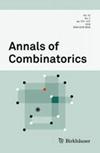使用罗尔标记算盘证明褶皱穆纳汉-中山规则
IF 0.7
4区 数学
Q4 MATHEMATICS, APPLIED
引用次数: 0
摘要
褶皱穆纳汉-中山(Murnaghan-Nakayama)规则描述了如何将舒尔函数与形式为 \(p_r\circ h_m\) 的褶皱的乘积分解为舒尔函数之和。我们使用 Loehr (SIAM J Discrete Math 24(4):1356-1370, 2010) 中引入的标注 abaci 对这一规则进行了简短的、完全组合式的证明。本文章由计算机程序翻译,如有差异,请以英文原文为准。

Proof of the Plethystic Murnaghan–Nakayama Rule Using Loehr’s Labelled Abacus
The plethystic Murnaghan–Nakayama rule describes how to decompose the product of a Schur function and a plethysm of the form \(p_r\circ h_m\) as a sum of Schur functions. We provide a short, entirely combinatorial proof of this rule using the labelled abaci introduced in Loehr (SIAM J Discrete Math 24(4):1356–1370, 2010).
求助全文
通过发布文献求助,成功后即可免费获取论文全文。
去求助
来源期刊

Annals of Combinatorics
数学-应用数学
CiteScore
1.00
自引率
0.00%
发文量
56
审稿时长
>12 weeks
期刊介绍:
Annals of Combinatorics publishes outstanding contributions to combinatorics with a particular focus on algebraic and analytic combinatorics, as well as the areas of graph and matroid theory. Special regard will be given to new developments and topics of current interest to the community represented by our editorial board.
The scope of Annals of Combinatorics is covered by the following three tracks:
Algebraic Combinatorics:
Enumerative combinatorics, symmetric functions, Schubert calculus / Combinatorial Hopf algebras, cluster algebras, Lie algebras, root systems, Coxeter groups / Discrete geometry, tropical geometry / Discrete dynamical systems / Posets and lattices
Analytic and Algorithmic Combinatorics:
Asymptotic analysis of counting sequences / Bijective combinatorics / Univariate and multivariable singularity analysis / Combinatorics and differential equations / Resolution of hard combinatorial problems by making essential use of computers / Advanced methods for evaluating counting sequences or combinatorial constants / Complexity and decidability aspects of combinatorial sequences / Combinatorial aspects of the analysis of algorithms
Graphs and Matroids:
Structural graph theory, graph minors, graph sparsity, decompositions and colorings / Planar graphs and topological graph theory, geometric representations of graphs / Directed graphs, posets / Metric graph theory / Spectral and algebraic graph theory / Random graphs, extremal graph theory / Matroids, oriented matroids, matroid minors / Algorithmic approaches
 求助内容:
求助内容: 应助结果提醒方式:
应助结果提醒方式:


